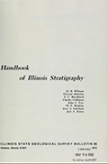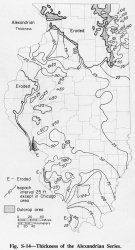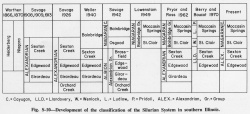Historical:Alexandrian Series
Lithostratigraphy: Hunton Limestone Megagroup
Chronostratigraphy: Paleozoic Erathem >>Silurian System >>Alexandrian Series
Allostratigraphy: Tippecanoe Sequence
Authors
H. B. Willman and Elwood Atherton
Name Origin
The Alexandrian Series (Savage, 1908, p. 110; 1916, p. 312; Weller, 1940, p. 19; Willman et al., 1967), is named for exposures in Alexander County.
Extent and Thickness
Alexandrian strata occur throughout most of the area of Silurian rocks (fig. S-14) and, where they fill erosional channels in the Maquoketa Shale Group, are locally as much as 150 feet thick.
Stratigraphic Position
The Alexandrian Series consists of early Silurian strata including and underlying the Microcardinalia Zone and overlying Ordovician rocks. The Alexandrian strata were included in the Niagaran until Savage (1908) recognized that they contain a fauna older than that in the lower part of the Niagaran type section in New York (fig. S-10). At first the Alexandrian Series included only the Girardeau and Edgewood Formations, but later Savage expanded the series to include the Orchard Creek Shale below and the Sexton Creek Limestone above. Weller (1940) returned the Orchard Creek to the Ordovician, and later Willman et al. (1967) followed suggestions by several authors and placed the Girardeau, also, in the Ordovician.
Description
Alexandrian strata throughout Illinois are generally argillaceous limestone or dolomite at the base, overlain by purer glauconitic limestone or dolomite that is very cherty in some areas. The series is divisible into two parts by a zone of Platymerella manniensis that is present at the base of the Kankakee Formation in northeastern and western Illinois but has not been found elsewhere.
References
SAVAGE, T. E., 1908, On the lower Paleozoic stratigraphy of southwestern Illinois: American Journal of Science, v. 25, p. 431-443; expanded in Illinois State Geological Survey Bulletin 8, p. 103-116.
SAVAGE, T. E., 1916, Alexandrian rocks of northeastern Illinois and eastern Wisconsin: Geological Society of America Bulletin, v. 27, p. 305-324.
WELLER, J. M., 1940, Geology and oil possibilities of extreme southern Illinois: Illinois State Geological Survey Report of Investigations 71, 71 p.
WILLMAN, H. B., et al., 1967, Geologic map of Illinois: Illinois State Geological Survey.
ISGS Codes
| Stratigraphic Code | Geo Unit Designation |
|---|---|


